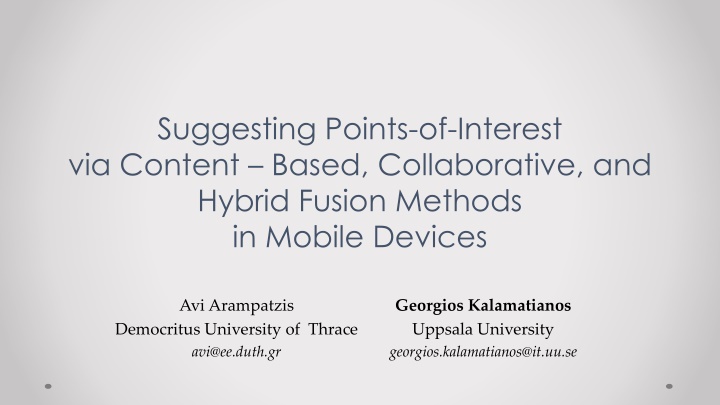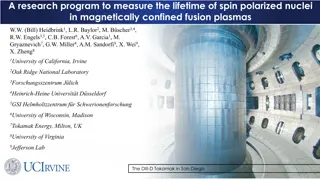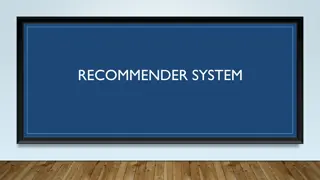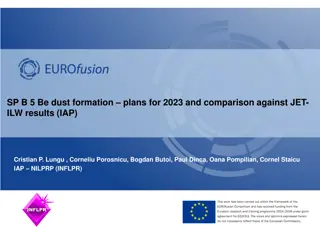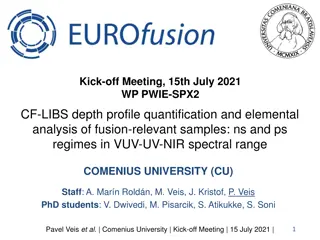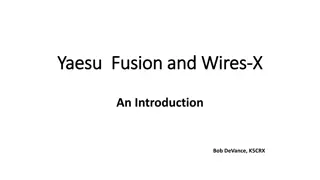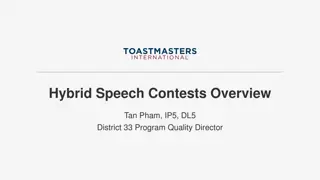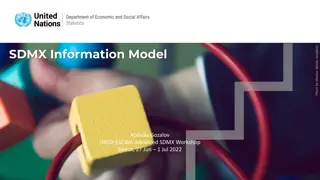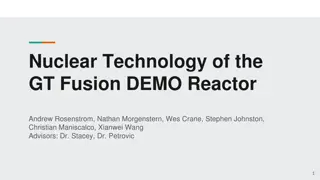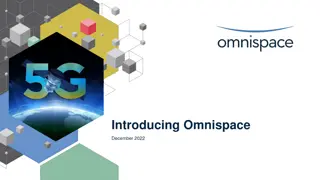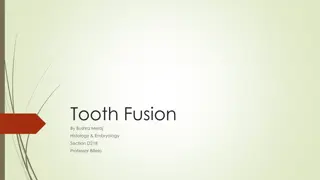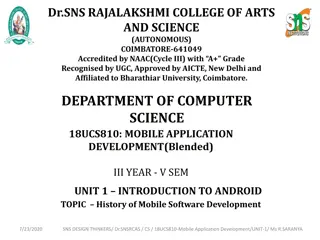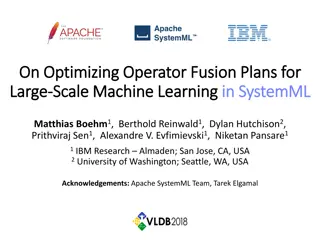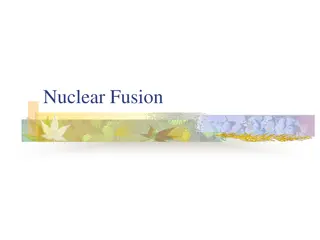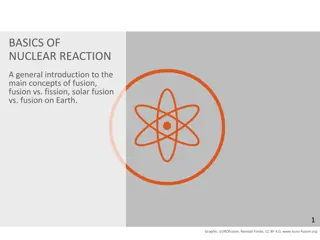Enhancing Mobile Touristic Recommendations with Content-Based, Collaborative, and Hybrid Fusion Methods
Mobile devices offer a unique opportunity for personalized touristic recommendations by leveraging user preferences and location data. This study explores the integration of content-based, collaborative, and hybrid fusion methods to suggest points of interest to users based on their profiles and current location. By addressing privacy concerns and utilizing strong computational abilities, the research aims to provide contextually relevant suggestions for improved user experiences.
Download Presentation

Please find below an Image/Link to download the presentation.
The content on the website is provided AS IS for your information and personal use only. It may not be sold, licensed, or shared on other websites without obtaining consent from the author.If you encounter any issues during the download, it is possible that the publisher has removed the file from their server.
You are allowed to download the files provided on this website for personal or commercial use, subject to the condition that they are used lawfully. All files are the property of their respective owners.
The content on the website is provided AS IS for your information and personal use only. It may not be sold, licensed, or shared on other websites without obtaining consent from the author.
E N D
Presentation Transcript
Suggesting Points-of-Interest via Content Based, Collaborative, and Hybrid Fusion Methods in Mobile Devices Avi Arampatzis Georgios Kalamatianos Uppsala University georgios.kalamatianos@it.uu.se Democritus University of Thrace avi@ee.duth.gr
Motivation Ubiquitous mobile devices o Well informed about owners interests o Strong computational ability o Sensors Opportunity for contextual touristic recommendations Catch: privacy intrusion
Presentation Outline Problem Definition Suggestion Methods Experimental Evaluation and Discussion of results Conclusions and directions for future research
Problem Definition Implicit Query: Here I am. What should I do? Given: o User preference profile (previous ratings of venues) o Set of candidate POIs o Location Return: o Ranked list of suggested POIs Controlled/fix collection provided by TREC 2015/2016 Contextual Suggestion Track
Suggestion Methods Content Based o Rocchio inspired o kNN - inspired Collaborative Filtering Fusion Methods o Rank based o Score - based
Weighted kNN Index Rated POIs Query Generation per Candidate POI Rating Context/Candidate POIs Include equation and explanation = k s r i i s = 1 i p k i = 1 i Indexing per User: Bag of words User Preferences Index per User Submit query to index (Indri) Sorted Indri Results per Candidate Apply kNN method recommendat ion list Query construction per Candidate: Bag of words POI Candidates Query per Candidate
Rated Rocchio Index POIs within the same location Generate Personal Query Submit weighted query Suggest Candidate POIs = , ,..., D d d d ,1 ,2 , n n n n T max r 1 R = (( ) ) Q r neutral r D n r r = D R r min n r Indexing per Location POI List Index per Location Query Candidate POI selection (sorted on score) Relevant POIs per location Recommendat ion List submission to relevant index Query construction (Rocchio-Like method) User Preferences Weighted User Queries
Collaborative Filtering 1. Construct M by N Utility Matrix (M: users, N: global POIs) 2. Center scores on average rating per user 3. Calculate Pearson s (Correlation Coefficient) for all pairs 4. Filter POIs out of context 5. Sort on predicted rating
Fusion Methods Rank Based: o Borda Count: Election method based o Condorcet (only different when combining three or more) Rating Based: o CombSUM
Dataset Description # 2015 2016 Users 209 238 Rated POIs / profile 30 30 or 60 Total Requests (Queries) 211 438 Candidate POIs / request 30 79-119, avg. 96.5
URL list Dataset Enrichment Check URL Initial Foursquare Profiles Search Foursquare Profile Search Yelp Profile Initial Yelp Profiles Average Unique keywords per POI Final Final Yelp Profiles Foursquare Profiles 2016 Collect Data from Foursquare (API) Collect Data from Yelp (API) Metadata Collection (URLs) 2015 Foursquare Profiles Data Yelp Profiles Data Metadata 0 10 20 30 40 50 60 After Enrichment Before Enrichment POI Data
Standalone Methods 2015 2016 NDCG@5 P@5 MRR NDCG@5 P@5 MRR WkNN 0.5553 0.5450 0.6774 0.3388 0.4690 0.6697 RRocchio 0.5305 0.5175 0.6795 0.3306 0.4724 0.6801 RRochio (MI) 0.4905 0.4815 0.6485 0.3360 0.4828 0.6367 CF 0.5468 0.5374 0.6814 - - - Median TREC 0.5356 0.5204 0.6758 0.2720 0.4120 0.5927 Best TREC 0.6055 0.5858 0.7404 0.3306 0.5069 0.6854
Complexity and Data Leaks Time Complexity Privacy leak Pre-process Suggestion Update Weighted kNN O(Nr) index rated POIs O(NaNr) run all candidate POI queries O(1) incremental index update on new user rating Area of interest Rated Rocchio O(Nr) train query O(Na) index candidates and run query O(1) incremental query update on new user rating Area of interest Collaborative Filtering O(MNr) calculate user s avg. rating & s O(NaMNr/N) calculate all s & weight average ratings O(MNr) update s & avg. or on any user s rating Area + all users ratings
Statistical significance: * : 5% ** :1% Fusion Methods 2015 2016 NDCG@5 P@5 MRR NDCG@5 P@5 MRR BL WkNN 0.5553 0.5450 0.6774 0.3388 0.4690 0.6697 CF-WkNN 0.5653 0.5536 0.7118 - - - Count Borda WkNN-RRocchio 0.5542 0.5299 0.7149 0.3232 0.4552 0.6165 CF-RRocchio 0.5717 0.5573 0.7094 - - - CF-WkNN 0.5794 0.5640 0.7180 - - - Combsum WkNN- RRocchio(MI) 0.5048 0.4796 0.6812 0.3319 0.4828 0.6023 CF-RRocchio(MI) 0.5346 0.5261 0.6732 - - - Borda Count 0.5830* 0.5630 0.7414** - - - 3-way Condorcet 0.5817* 0.5611 0.7414** - - - CombSUM 0.5397 0.5223 0.7026 - - - TREC Median 0.5356 0.5204 0.6758 0.2720 0.4120 0.5927 Best 0.6055 0.5858 0.7404 0.3306 0.5069 0.6854
Conclusions Our proposed content based methods are effective (above median to best) efficient to implement locally and not very privacy compromising Collaborative Filtering predictably suffers from data sparsity Rank-based merging are robust (may improve effectiveness) Rating-based merging are effective (especially with more results to merge) but may depend on the rating mapping Merging sharpens the ranking
Ideas for Future Research WkNN: investigate mechanisms alternative to tf.idf for semantic distance Rated Rocchio: investigate alternative (e.g. non-linear) centroid weightings Rating based fusion: score to rating mapping Context enrichment (temporal/weather data)
Thank You! Questions?
